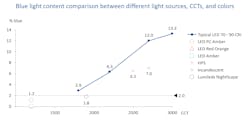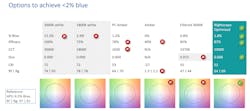Lumileds aims to take back the night with low-blue LED offerings
This week, San Jose, Calif.–based Lumileds announced its latest LED technology development — NightScape — which enables significantly reduced blue-light content in outdoor solid-state lighting products serving in roadway, pedestrian, landscape, and other applications.
Continued findings connecting escalating light pollution and sky glow with increasing amounts of blue light emitted from expanded installations of outdoor lighting have prompted practical industry guidelines, such as those from the Illuminating Engineering Society and DarkSky (formerly the International Dark-Sky Association), as well as DesignLights Consortium LUNA technical requirements for outdoor lighting intended to balance environmental-targeted concerns and energy efficiency needs in finished SSL products.
The Lumileds release specifically cites dark-sky initiatives on the island of Maui, which instituted an ordinance as of July 1 that “All outdoor lighting fixtures, except for neon, must limit short wavelength content to no more than 2 percent of blue light content” in an effort to reduce the impact of artificial light at night on animal species, plants, and even insect behavior and preserve the natural habitat and ecodiversity of the island. Given the public interest in dark-sky efforts, combined with renewed pushes for reduced energy consumption across areas around the globe, it’s likely that such requirements could influence other regions’ regulatory activities and prompt further product development advances.
The concept of lowering blue emissions from LEDs is not altogether new. Indeed, in July 2021, packaged LED supplier Nichia launched its NVSW219F series 1800K-CCT LED, citing customer preferences for the “nostalgic” warm glow of high-pressure sodium for applications including historic districts, but with an improved CRI over HPS — closer to 70 — for increased visibility. And amber LEDs have been utilized in what some OEMs have called "wildlife-" or "turtle-friendly" luminaires.
Still, Lumileds notes that the amount of blue light emitted by different types of light sources can be misconstrued, explaining that it is “measured as the ratio of blue light between 400 and 500 nanometers to the total amount of visible light emitted from the source.” The company compares the percentage of blue light emitted from different light sources, CCTs, and colors in the above graph, and other LED-specific parameters such as efficacy, CCT, CRI, color gamut (Rg), and color fidelity (Rf) according to TM-30 below, with color vector graphics.
While the data show a phosphor-converted amber LED can achieve very low blue-light emission, luminous efficacy is greatly penalized. An 1800K white LED emits more than the 2% blue threshold of the Maui ordinance while achieving approximately 75% efficacy, according to the accompanying charts. Lumileds claims its NightScape optimized LEDs will deliver 1.8% blue light at 87% efficacy, while delivering 1900K-CCT illumination with chromaticity close to the blackbody locus.
Lumileds senior director of business development Willem Sillevis-Smitt said, “Too often our collective behavior is to ask how we can adjust our lighting solutions to the LEDs available.” With the progressively urgent messaging to reduce the negative impacts of excessive blue-light emission, he continued, “What we did instead was ask how we can address this real-world lighting problem. … We challenged our engineers and scientists to create high-quality white light with lower blue content that could improve the night-time environment for everyone and everything.”
When asked about the method to achieve reduced blue emissions with NightScape technology, a Lumileds spokesperson confirmed that no violet-pump LED is used but declined to elaborate further on the potential phosphor mix at this time. The spokesperson affirmed that the technology is sampling now and will reach volume production in September. The company’s press announcement states that LUXEON 3030 HE Plus and 5050 Square LEDs will be the first on the market with NightScape optimization, with physical dimensions and optical radiation patterns matching the existing parts for faster integration.
CARRIE MEADOWS is editor-in-chief of LEDs Magazine, with 20-plus years’ experience in business-to-business publishing across technology markets including solid-state technology manufacturing, fiberoptic communications, machine vision, lasers and photonics, and LEDs and lighting.
Follow our LinkedIn page for our latest news updates, contributed articles, and commentary, and our Facebook page for events announcements and more. You can also find us on Twitter.

Carrie Meadows | Editor-in-Chief, LEDs Magazine
Carrie Meadows has more than 20 years of experience in the publishing and media industry. She worked with the PennWell Technology Group for more than 17 years, having been part of the editorial staff at Solid State Technology, Microlithography World, Lightwave, Portable Design, CleanRooms, Laser Focus World, and Vision Systems Design before the group was acquired by current parent company Endeavor Business Media.
Meadows has received finalist recognition for LEDs Magazine in the FOLIO Eddie Awards, and has volunteered as a judge on several B2B editorial awards committees. She received a BA in English literature from Saint Anselm College, and earned thesis honors in the college's Geisel Library. Without the patience to sit down and write a book of her own, she has gladly undertaken the role of editor for the writings of friends and family.
Meadows enjoys living in the beautiful but sometimes unpredictable four seasons of the New England region, volunteering with an animal shelter, reading (of course), and walking with friends and extended "dog family" in her spare time.






![The DesignLights Consortium continues to make progress in shifting outdoor lighting products and implementation practices toward a more restrained and thoughtful strategy. [Image does not represent a DLC qualified fixture.] The DesignLights Consortium continues to make progress in shifting outdoor lighting products and implementation practices toward a more restrained and thoughtful strategy. [Image does not represent a DLC qualified fixture.]](https://img.ledsmagazine.com/files/base/ebm/leds/image/2024/08/66be810888ae93f656446f61-dreamstime_m_265700653.png?auto=format,compress&fit=&q=45&h=139&height=139&w=250&width=250)
